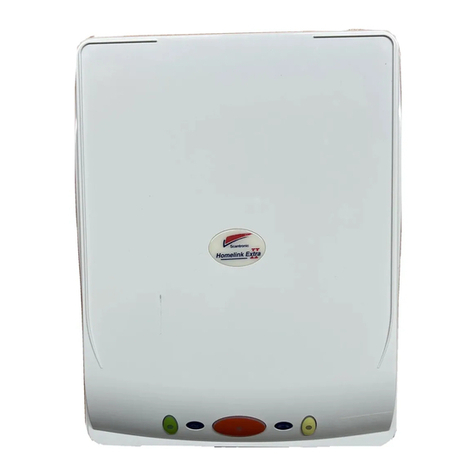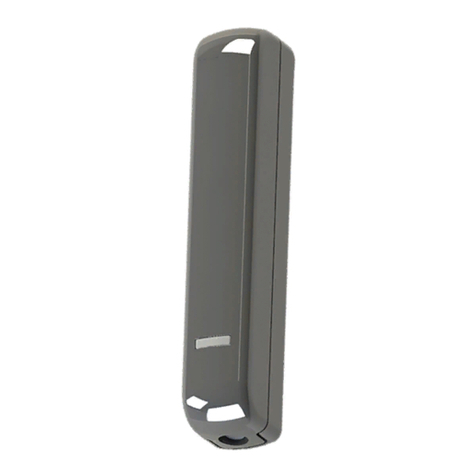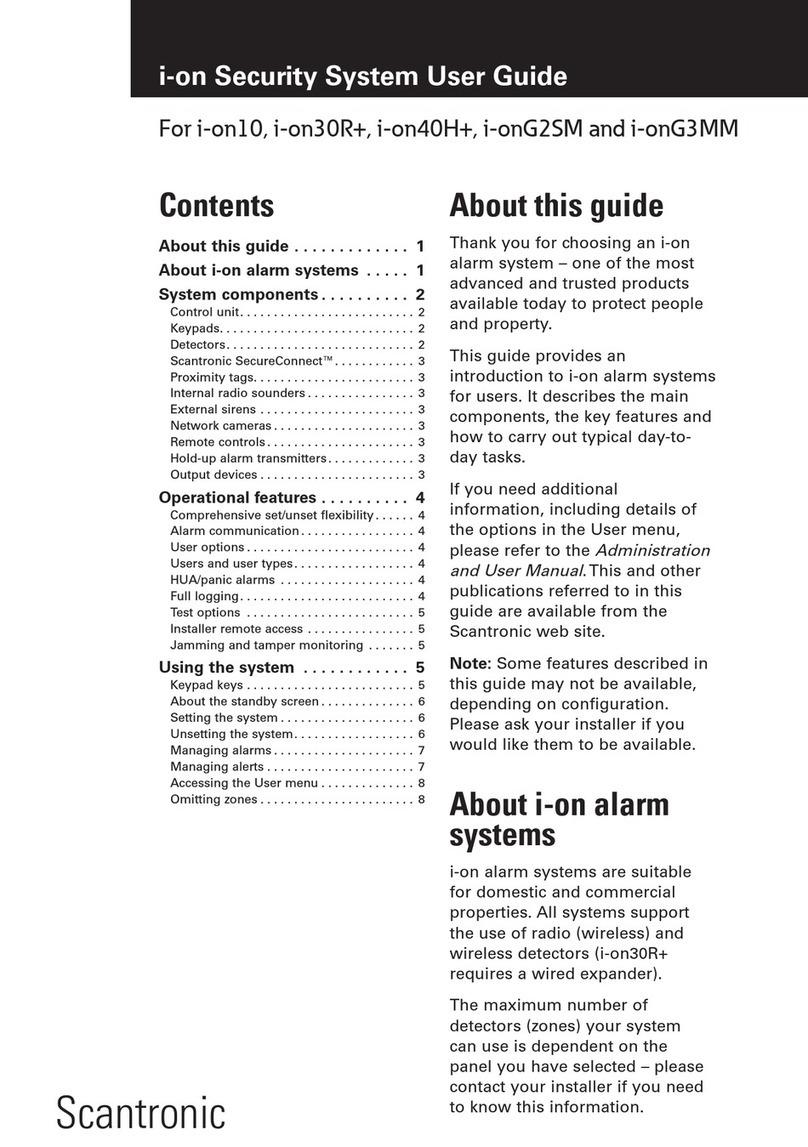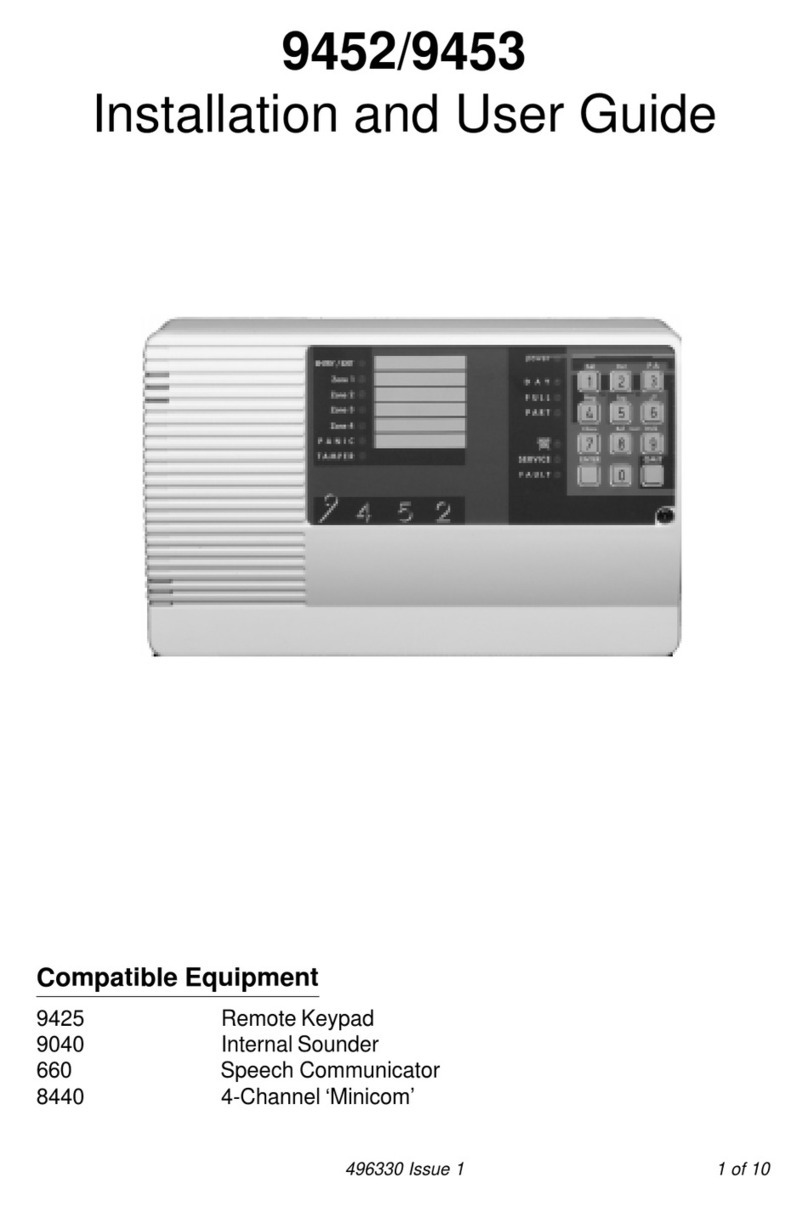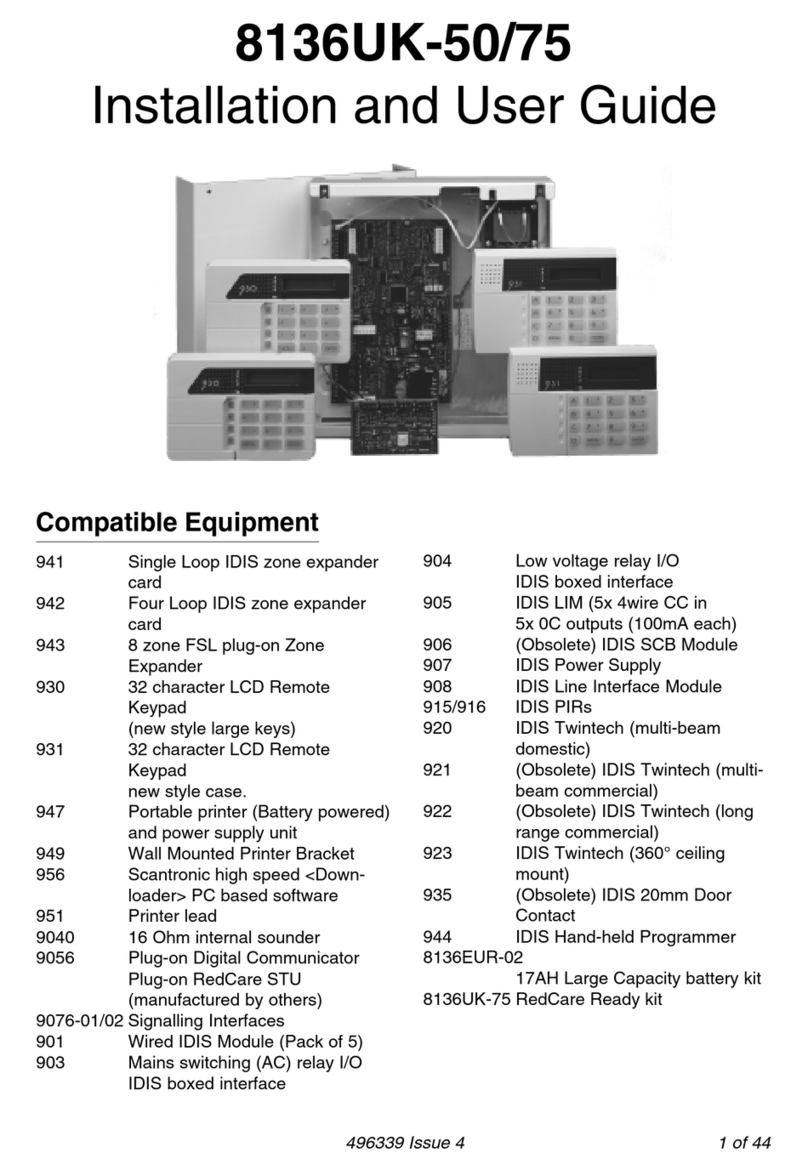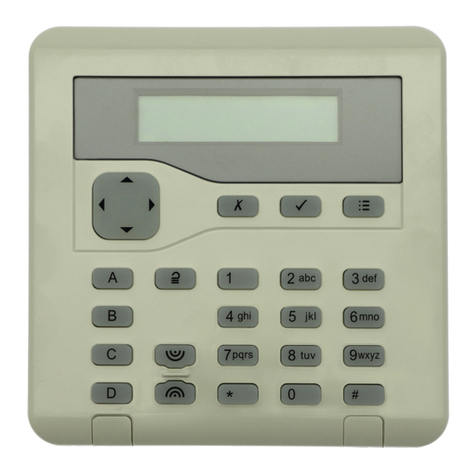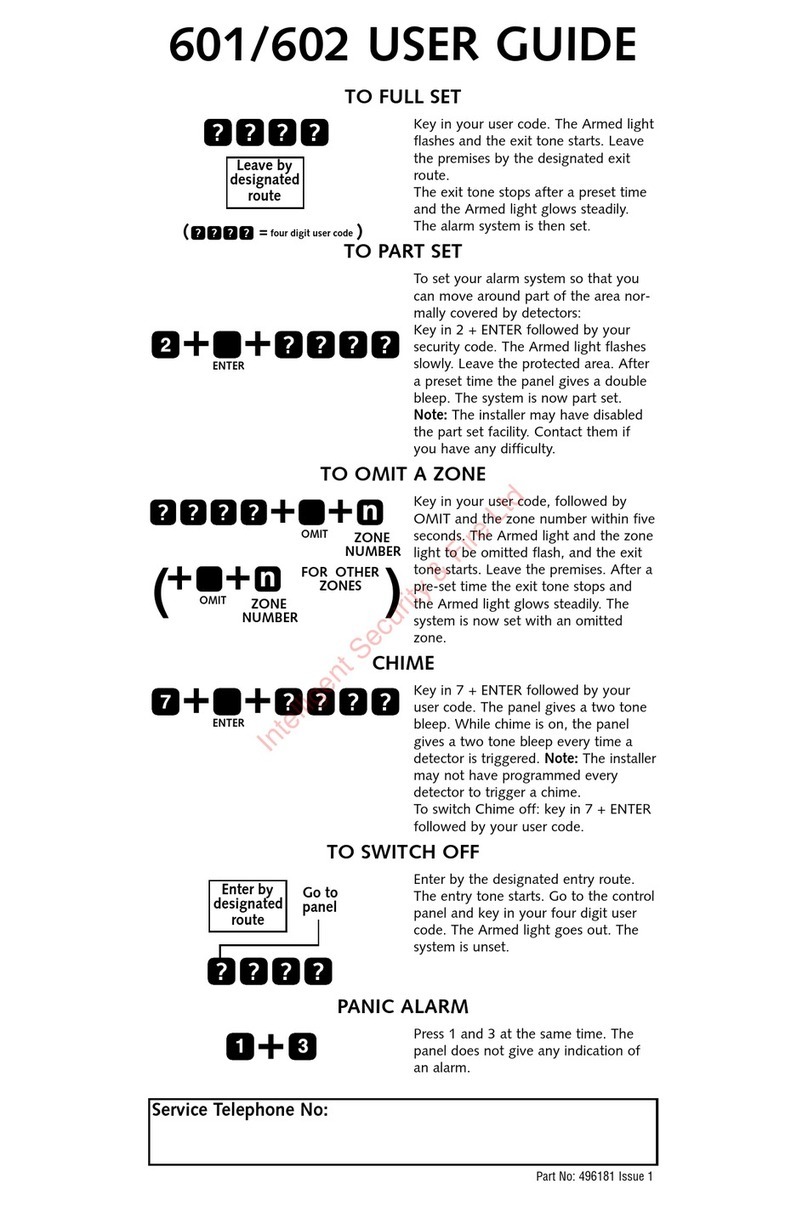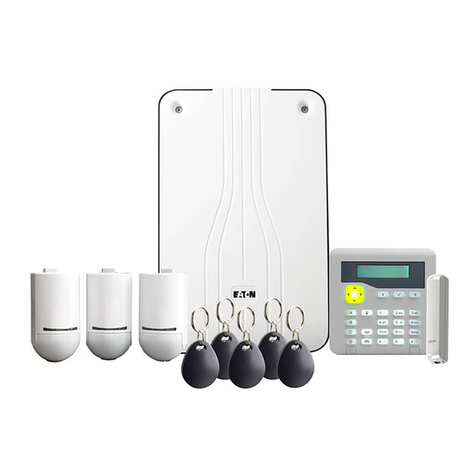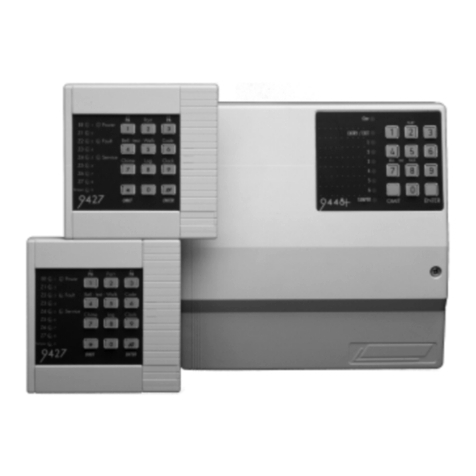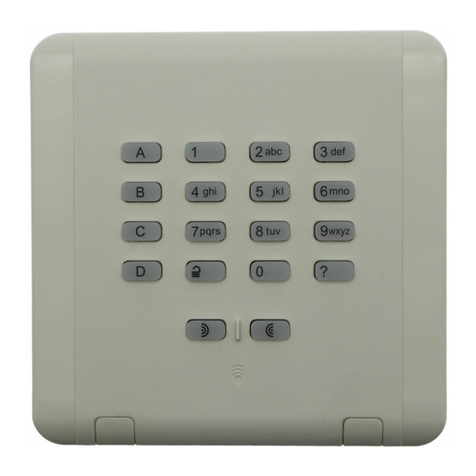
Page 2
•
Verwendet Rollcodetechnik für verbesserte
Sicherheit
So aktivieren Sie das System
1. Geben Sie Ihren Zugriffscode ein, oder
drücken Sie dieTaste ? und halten Sie Ihren
Chipschlüssel vor (Anmerkung1).
2. Drücken Sie die entsprechende ABCD-Taste,
wie von Ihrem Errichter konfiguriert. Die
Tasten sind normalerweise wie folgt
konfiguriert:
Teilset des Systems aktivieren:
•
A– Aktiviert das System vollständig.
•
B, C oder D− AktiviertTeilset B, C oder D.
System mit Teilbereichen:
•
A– Aktiviert denTeilbereich, dem die
KEY-RAS zugewiesen ist, vollständig. (Das
Bedienteil kann nur einem Teilbereich
zugewiesen werden.)
•
B– Aktiviert einTeilset des zugewiesenen
Teilbereichs.
3. Verlassen Sie den Bereich über den
festgelegten Weg.
Wenn die KEY-RAS im 2-Wege-Modus
ist, hören Sie unter Umständen einen
Ausgangston und dieTaste, die Sie gedrückt
haben, blinkt rot. Das bedeutet, dass
der Errichter einen „Ausgangszeitraum“
konfiguriert hat– einen Zeitraum, in dem
Sie den Bereich verlassen können.
4. Das System wird aktiviert.
Wenn die KEY-RAS im 2-Wege-Modus ist,
leuchtet dieTaste, die Sie gedrückt haben,
weiter rot, entweder für ein paar Sekunden
oder dauerhaft, solange das System aktiviert
ist (abhängig von der Konfiguration). Das
bedeutet, dass die Aktivierung erfolgreich
war.
Wenn das System nicht aktiviert
wird
Die ABCD-LEDs blinken bei einem aktiven
Melder oder einer aktiven Störung, die Sie
daran hindert, das System zu aktivieren,
abwechselnd rot und grün. Informationen zum
jeweiligen Ereignis finden Sie auf einem Panel
oder einem Bedienteil, das ein Display hat.
So deaktivieren Sie das System
1. Gehen Sie über den festgelegten Weg zur
KEY-RAS. Weichen Sie nicht von diesem Weg
ab, da Sie ansonsten einen Alarm auslösen
könnten.
Wenn die KEY-RAS im 2-Wege-Modus
ist, hören Sie unter Umständen einen
Eingangston (sofern dieser vom Errichter
konfiguriert wurde).
2. Geben Sie innerhalb der vorgegebenen Zeit
Ihren Zugriffscode ein und drücken Sie die
Taste , oder halten Sie Ihren Chipschlüssel
vor (Anmerkung 1). Der Eingangston stoppt
und das System wird deaktiviert.
Wenn die KEY-RAS im 2-Wege-Modus ist,
leuchten die ABCD-Tasten weiter grün,
entweder für ein paar Sekunden oder
dauerhaft, solange das System deaktiviert
ist (abhängig von der Konfiguration). Das
bedeutet, dass die Deaktivierung erfolgreich
war.
So schalten Sie einen Alarm
stumm
Hinweis: Ein Eindringling kann in Ihren
Räumlichkeiten bzw. auf Ihrem Gelände sein.
Betreten Sie Bereiche nur, wenn Sie sich sicher
sind, dass Sie sich keiner Gefahr aussetzen.
3. Geben Sie Ihren Zugriffscode ein und
drücken Sie dieTaste , oder halten Sie
Ihren Chipschlüssel vor (Anmerkung1).
Der Alarm stoppt und das System wird
deaktiviert.
4. Gehen Sie zu einem Standard-Bedienteil,
um die Alarmmeldung zu sehen und um sie
zurückzusetzen.
So fragen Sie den Aktivierungs-/
Deaktivierungsstatus ab
Hinweis: Diese Funktion ist nur verfügbar,
wenn die KEY-RAS im 2-Wege-Modus ist, und
ist nur nützlich, wenn die LEDs nicht dauerhaft
leuchten.
1. Geben Sie Ihren Zugriffscode ein, oder
drücken Sie dieTaste ? und halten Sie Ihren
Chipschlüssel vor (Anmerkung1).
2. Drücken Sie die Taste ?.
3. Die ABCD-Tasten zeigen den Status an:
•
Wenn das System aktiviert ist, leuchtet
dieTaste, die zur Aktivierung diesesTeils
des Systems verwendet wurde, rot. Wenn
das System z.B. vollständig aktiviert ist,
istTaste A rot.
•
Wenn das System deaktiviert ist, sind alle
ABCD-Tasten grün.
So lösen Sie einen Überfallalarm
aus
Drücken Sie gleichzeitig die Taste und die
Taste . DieTasten müssen zuerst von Ihrem
Installateur aktiviert werden. Das System muss
nicht aktiviert werden.
Sie könnten beispielsweise einen
Überfallalarm (Panikalarm) auslösen, wenn Sie
wissen, dass jemand in Ihre Räumlichkeiten
eingedrungen ist und Sie sofort einen Alarm
auslösen wollen.
So schalten Sie ein
Ausgangsgerät ein oder aus
1. Geben Sie Ihren Zugriffscode ein, oder
drücken Sie dieTaste ? und halten Sie Ihren
Chipschlüssel vor (Anmerkung1).
2. Drücken Sie die entsprechende ABCD-Taste,
die von Ihrem Errichter konfiguriert wurde.
Anmerkung 1: Wenn die KEY-RAS nur mit
Batterien betrieben wird, geht sie nach
Inaktivität in den Ruhemodus über, um Strom
zu sparen. Die KEY-RAS wacht automatisch
auf, wenn ihr Eingangs-Tongeber startet
(nur 2-Wege-Modus). Wenn die KEY-RAS im
Ruhemodus ist und ihr Eingangston nicht
ertönt, drücken Sie zuerst die Taste ? und
halten Sie dann Ihren Chipschlüssel vor, um
das Gerät „aufzuwecken“.
Hinweis: Aufgrund der Art der
Funkkommunikation kann es zu einer kurzen
Verzögerung beim Starten und Stoppen der
Töne am KEY-RAS kommen.
Die Informationen, Empfehlungen, Beschreibungen und
Sicherheitshinweise im vorliegenden Dokument basieren
auf den Erfahrungswerten und der Beurteilung der Eaton
Corporation („Eaton“) und decken möglicherweise nicht
alle Eventualitäten ab. Sollten darüberhinausgehende
Informationen benötigt werden, stehen Mitarbeiter
des Vertriebsbüros von Eaton gern zur Verfügung.
Der Verkauf des in diesem Dokument beschriebenen
Produkts unterliegt den in den entsprechenden
Eaton-Verkaufsrichtlinien oder anderen vertraglichen
Vereinbarungen zwischen Eaton und dem Käufer
festgelegten Geschäftsbedingungen.
ES BESTEHEN KEINERLEI ABSPRACHEN,
VEREINBARUNGEN, GARANTIEN (AUSDRÜCKLICHE
ODER STILLSCHWEIGENDE), EINSCHLIESSLICH
GARANTIEN HINSICHTLICH DER EIGNUNG
FÜR EINEN BESTIMMTEN ZWECK ODER DER
GEBRAUCHSTAUGLICHKEIT, MIT AUSNAHME DER IN
BESTEHENDEN VERTRÄGEN ZWISCHEN DEN PARTEIEN
AUSDRÜCKLICH AUFGEFÜHRTEN. IN DERARTIGEN
VERTRÄGEN SIND SÄMTLICHE VERPFLICHTUNGEN
SEITENS EATON FESTGELEGT. DER INHALT DES
VORLIEGENDEN DOKUMENTS DARF NICHT ALS TEIL
ODER ZUR ABÄNDERUNG EINES VERTRAGS ZWISCHEN
DEN PARTEIEN DIENEN.
Unter keinen Umständen ist Eaton dem Käufer oder
Benutzer gegenüber vertraglich, aus unerlaubter Handlung
heraus (einschließlich Fahrlässigkeit), in Kausalhaftung
oder anderweitig für etwaige besondere, mittelbare,
Neben- oder Folgeschäden oder Verluste haftbar,
einschließlich Schäden oder Verluste in Bezug auf die
Nutzung von Geräten, Anlagen oder des Stromsystems,
Kapitalkosten, Stromausfälle, Zusatzkosten für die
Verwendung bestehender Energieversorgungsanlagen
oder für Ansprüche gegen den Käufer oder Benutzer
seitens seiner Kunden, die sich aus der Nutzung der
hierin enthaltenen Informationen, Empfehlungen und
Beschreibungen ergeben. Änderungen der in diesem
Dokument enthaltenen Informationen vorbehalten.
© 2019 Eaton. Eaton, Security House, Vantage Point
Business Village, Mitcheldean, GL17 0SZ, Vereinigtes
Königreich. www.touchpoint-online.com
Produkt-Support (Großbritannien)Tel.: +44 (0) 1594
541978, montags bis freitags 08:30 bis 17:00 Uhr
FR
Introduction
Le KEY-RAS vous permet d’activer, de
désactiver ou d’activer partiellement le
système, et aussi d’allumer ou d’éteindre des
périphériques de sortie (comme des lampes).
En fonction de votre centrale d’alarme,
le KEY-RAS est configuré en mode
unidirectionnel ou bidirectionnel. En mode
bidirectionnel, le KEY-RAS peut afficher l’état
actuel d’activation du système et émettre des
tonalités d’entrée, de sortie et d’alarme. Ces
fonctions ne sont pas disponibles pour le
mode unidirectionnel.
Caractéristiques:
•
Utilisé pour activer, désactiver ou activer
partiellement le système, et aussi pour
contrôler des périphériques de sortie
•
Lecteur de proximité interne
•
Touche Requête (fonctionne uniquement
pour le mode bidirectionnel)
•
Touches Agression (AGR) et ABCD
programmables
•
Utilise une technologie «rolling code»
(code tournant) pour une sécurité renforcée
Pour armer le système
1. Tapez votre code d’accès ou appuyez
sur la touche ? et présentez votre badge
(remarque 1).
2. Appuyez sur la touche ABCD appropriée,
selon la configuration effectuée par votre
installateur. Les touches sont généralement
configurées comme suit:
Système à armement partiel:
•
A − Armement total.
•
B, C ou D − Armement partiel de B, C
ou D.
Système partitionné:
•
A − Armement total de la partition
affectée pour le KEY-RAS. (Le clavier ne
peut être affecté qu’à une seule partition.)
•
B − Armement partiel de la partition
affectée.
3. Sortez en suivant l’itinéraire désigné.
Si le KEY-RAS est en mode bidirectionnel,
vous entendrez une tonalité de sortie et
la touche que vous avez appuyée clignote
en rouge. Ceci indique que l’installateur
a configuré une «durée de sortie», qui
correspond au temps imparti pour sortir.
4. Le système est armé.
Si le KEY-RAS est en mode bidirectionnel,
la touche que vous avez appuyée reste
allumée en rouge, pendant quelques
secondes ou en continu pendant que le
système reste armé (en fonction de la
configuration). Ceci indique que le système
est correctement armé.
